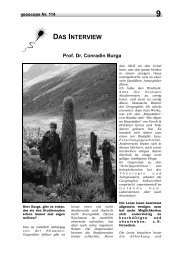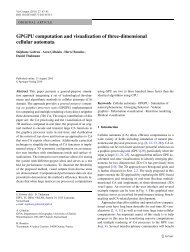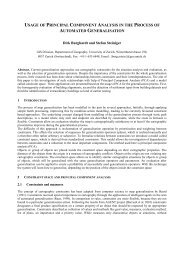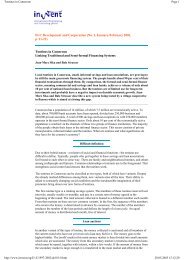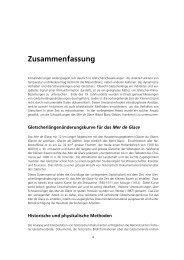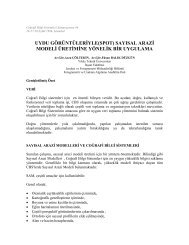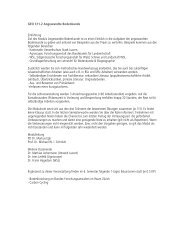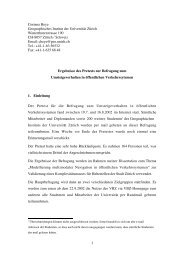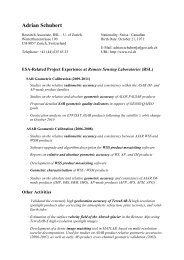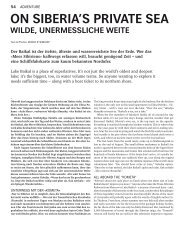KYRGYZSTAN TODAY Policy briefs on - Department of Geography
KYRGYZSTAN TODAY Policy briefs on - Department of Geography
KYRGYZSTAN TODAY Policy briefs on - Department of Geography
You also want an ePaper? Increase the reach of your titles
YUMPU automatically turns print PDFs into web optimized ePapers that Google loves.
Types and scale <strong>of</strong> judicial corrupti<strong>on</strong><br />
In recent years, almost all documents that describe the socio-ec<strong>on</strong>omic and political<br />
situati<strong>on</strong> in the Kyrgyz Republic menti<strong>on</strong> corrupti<strong>on</strong>. One resoluti<strong>on</strong> <strong>of</strong> the Kyrgyz<br />
Security Council c<strong>on</strong>cluded that “Corrupti<strong>on</strong> activities and other related crimes go<br />
deeper into such areas as ec<strong>on</strong>omy, finances, public administrati<strong>on</strong> and services, which<br />
significantly impedes social, ec<strong>on</strong>omic, political and democratic reforms in the Kyrgyz<br />
Republic” [11].<br />
The escalati<strong>on</strong> <strong>of</strong> corrupti<strong>on</strong> and its qualities goes hand-in-hand with depreciati<strong>on</strong><br />
<strong>of</strong> spiritual values, admissibility <strong>of</strong> means to increase prosperity, and eliminati<strong>on</strong> <strong>of</strong><br />
the regulators <strong>of</strong> civilized social behavior, such as morality, law, and public opini<strong>on</strong>.<br />
This is where the greatest danger <strong>of</strong> corrupti<strong>on</strong> lies as a form <strong>of</strong> social pathology lies<br />
[1, p. 5]. Another dangerous trend in the development <strong>of</strong> corrupti<strong>on</strong> is increasing public<br />
tolerance <strong>of</strong> corrupti<strong>on</strong>.<br />
One <strong>of</strong> the main causes <strong>of</strong> the change <strong>of</strong> the political regime in Kyrgyzstan in 2005<br />
was rampant corrupti<strong>on</strong>, including corrupti<strong>on</strong> in the judiciary, which covered the entire<br />
country and was largely c<strong>on</strong>d<strong>on</strong>ed and even encouraged by authorities.<br />
Before evaluating corrupti<strong>on</strong> in the judiciary, it is crucial to clarify terms. In a broad<br />
sense, by corrupti<strong>on</strong> we mean a social instituti<strong>on</strong>, <strong>on</strong>e aspect <strong>of</strong> the management system<br />
that is closely related to other social instituti<strong>on</strong>s, mostly political, ec<strong>on</strong>omic and cultural<br />
<strong>on</strong>es.<br />
Corrupti<strong>on</strong> is a complicated and complex social phenomen<strong>on</strong> with multiple<br />
layers and structures, and expressed through various corrupt acti<strong>on</strong>s. Such acti<strong>on</strong>s are<br />
pr<strong>of</strong>it-oriented, and they damage the functi<strong>on</strong>ing <strong>of</strong> society and the state in general. In<br />
legislative terms, corrupti<strong>on</strong> may be briefly defined as: violating the law, mostly through<br />
crimes, by taking bribes, abusing authority and so <strong>on</strong> for un<strong>of</strong>ficial purposes [6, p. 1].<br />
Therefore, using this logic <strong>on</strong>e can say that judicial corrupti<strong>on</strong> is using the status <strong>of</strong> a<br />
judge for un<strong>of</strong>ficial purposes.<br />
Rasma Karklins talks about the following types <strong>of</strong> corrupt acti<strong>on</strong>s in the judiciary:<br />
– trade in court decisi<strong>on</strong>s;<br />
– falsified legal prosecuti<strong>on</strong>, using scapegoats;<br />
– absence <strong>of</strong> legal prosecuti<strong>on</strong>.<br />
This classificati<strong>on</strong> seems too narrow. Corrupti<strong>on</strong> in the courts includes any type<br />
<strong>of</strong> illegal influence that undermines the impartiality <strong>of</strong> court proceedings and court<br />
decisi<strong>on</strong>s, from giving bribes to judges to arranging court decisi<strong>on</strong>s in favor <strong>of</strong> <strong>on</strong>e<br />
litigant or refusing to make a ruling at all. Corrupti<strong>on</strong> in the courts includes the abuse <strong>of</strong><br />
funds allocated for the functi<strong>on</strong>ing <strong>of</strong> the judiciary and judicial authority. An example is<br />
a case when a judge hires his or her family members as court employees, or manipulates<br />
c<strong>on</strong>tracts <strong>on</strong> c<strong>on</strong>structing or furnishing courtrooms. Corrupti<strong>on</strong> can be manifested in<br />
biased distributi<strong>on</strong> <strong>of</strong> judges to handle specific cases, or to c<strong>on</strong>duct pre-trial procedures,<br />
for example when a court clerk ostensibly loses cases or evidence in exchange for certain<br />
remunerati<strong>on</strong>. Corrupti<strong>on</strong> can be a factor in any proceeding or court decisi<strong>on</strong>, as well as<br />
in executing court decisi<strong>on</strong>s and verdicts, or the lack there<strong>of</strong> [14].<br />
The experts 1 surveyed identified the following features <strong>of</strong> judicial corrupti<strong>on</strong>:<br />
• existence <strong>of</strong> c<strong>on</strong>crete subjects involved in corrupt relati<strong>on</strong>s (a corrupt judge and<br />
a client), distributi<strong>on</strong> <strong>of</strong> social roles (e.g., bribe-giver, bribe-receiver, mediator);<br />
1<br />
The method <strong>of</strong> expert evaluati<strong>on</strong>s was used for the purpose <strong>of</strong> this article. The experts who were<br />
surveyed are court employees, law enforcement <strong>of</strong>ficers and defense attorneys.<br />
145






